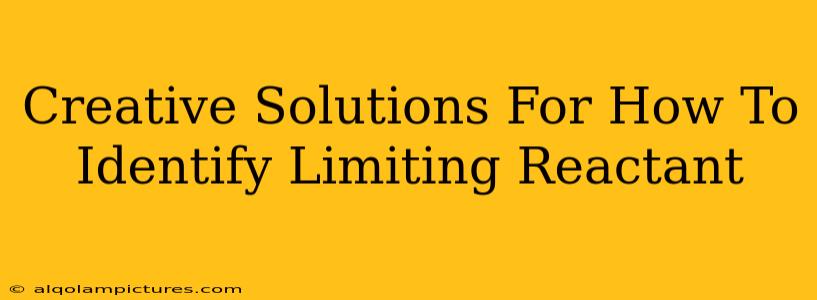Identifying the limiting reactant is a crucial concept in stoichiometry, often tripping up chemistry students. But fear not! This isn't some arcane alchemical mystery; with the right approach and a few creative problem-solving strategies, you can master this concept and ace your next exam. This guide provides creative solutions and methods to help you quickly and accurately identify the limiting reactant in any chemical reaction.
Understanding the Limiting Reactant: The Bottleneck Analogy
Before diving into methods, let's clarify the core idea. The limiting reactant (also called the limiting reagent) is the reactant that's completely consumed first in a chemical reaction. Think of it like a bottleneck in a factory assembly line. No matter how much of other materials you have, production stops when the bottleneck material runs out. Similarly, the limiting reactant determines the maximum amount of product that can be formed.
The Importance of Mole Ratios
The key to finding the limiting reactant lies in understanding mole ratios. These ratios, derived from the balanced chemical equation, tell us the proportional amounts of reactants needed for complete reaction. For example, in the reaction 2H₂ + O₂ → 2H₂O, the mole ratio of H₂ to O₂ is 2:1. This means you need twice as many moles of hydrogen as oxygen for a complete reaction.
Creative Methods for Identifying the Limiting Reactant
Now, let's explore some engaging and effective techniques to pinpoint that limiting reactant:
1. The "Mole-to-Mole" Comparison Method: A Classic Approach
This is a straightforward method. Follow these steps:
- Balance the equation: Ensure your chemical equation is perfectly balanced to get accurate mole ratios.
- Convert to moles: Convert the given masses of each reactant into moles using their molar masses.
- Use the mole ratio: Compare the actual mole ratio of reactants to the stoichiometric mole ratio from the balanced equation. For each reactant, determine how many moles of the other reactant would be needed for complete consumption.
- Identify the limitation: Whichever reactant requires more of the other reactant than is actually available is the limiting reactant.
Example: Let's say we have 10 grams of hydrogen and 20 grams of oxygen reacting to form water.
- Step 1: Balanced equation: 2H₂ + O₂ → 2H₂O
- Step 2: Moles of H₂ = 10g / (2 g/mol) = 5 moles; Moles of O₂ = 20g / (32 g/mol) ≈ 0.625 moles
- Step 3: If we use all 5 moles of H₂, we'd need 2.5 moles of O₂ (5 mol H₂ * (1 mol O₂ / 2 mol H₂)). If we use all 0.625 moles of O₂, we'd need 1.25 moles of H₂ (0.625 mol O₂ * (2 mol H₂ / 1 mol O₂)).
- Step 4: Since we only have 0.625 moles of O₂, and we need 2.5 moles to react with all the hydrogen, oxygen is the limiting reactant.
2. The "Conceptual Visualization" Method: Think it Through!
Sometimes, a visual approach is more intuitive. Imagine you have a specific number of Lego bricks of different types, needed to build a certain model. Which type of brick will run out first, determining how many complete models you can build? Apply this analogy to your chemical reaction. This is helpful for grasping the underlying concept.
3. The "Shortcut" Method (for simple reactions): A quick calculation.
For reactions with simple stoichiometry (1:1 ratios), you can sometimes skip some steps. Just compare the moles directly. The reactant with fewer moles is the limiting reactant. Caution: Only use this shortcut when the stoichiometric coefficients of the reactants are equal to 1.
Beyond the Basics: Tackling Complex Scenarios
Remember, the techniques described above form a solid foundation. As you progress, you'll encounter more complex scenarios involving multiple reactants or situations where impurities are present. These require a more detailed approach, but the core principles remain the same.
Practice Makes Perfect: Boosting your skills
Mastering the limiting reactant requires consistent practice. Work through various problems, starting with simple examples and gradually increasing the complexity. Online resources and textbooks offer a wealth of practice problems. Don't be afraid to ask for help when needed!
By utilizing these creative methods and embracing consistent practice, identifying the limiting reactant will become second nature. Good luck, and happy problem-solving!

